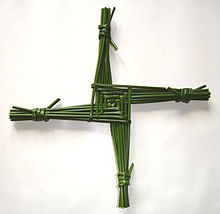
St. Brigid's Cross: February has arrived
By Mary Maguire

For the Irish, the arrival of February means that spring is here, which brings new life and hope. February 1st always brings back memories of the fun times we had at school making the St Brigid's Cross. The Celts divided the year into two halves, the long bright days of samh or summer the dark short days of gamh or winter. In these two halves were four festivals to mark each season. February 1st is the Celtic feast of IMBOLC dedicated to the Irish fertility goddess Brigid, and it marks the first day of Spring. This feast day is then shared with Naomh Brid or St Brigid (c.451-525), the patroness of Ireland. Therefore, In Ireland February 1st is known as Feile Bride or St Brigid's Day, celebrating both the Saint and the 1st day of Spring.
Brigid was born near Dundalk, Co Louth. Her mother was a Christian, and from her she learned cattle farming and dairying. This was her occupation after she made a vow to live a life of holy chastity. She is celebrated for her generosity to the poor. Feile Bride (Festival of Brigid) is celebrated in the town of Cill Dara (Kildare), which means “church of the oak.” The town dates from the 5th Century and became one of the three most important Christian foundations in Celtic Ireland. St Mel of Ardagh and Bishop MacCaille, also credited with the consecration of Brigid, established the first community beneath an oak tree on a hill on the edge of the Curragh (hence the name Cill Dara, the church of the oak). Not too far away lived the King of Leinster who donated the site to Brigid. The story goes that he offered Brigid as much land as her cloak would cover. When she spread it, it stretched out to cover the entire plain of 5000 acres! From this land, she was able set up her new community and had plenty of fertile land for crops and to graze sheep and cows. Her community was unique because it was a mix of nuns and monks. Her small Oratory at Cill Dara became a center of religion and learning, and developed into a cathedral city.
One of the most widespread Irish customs associated with St Brigid is the weaving of the Cros Bride (St Brigid’s Cross). In her time, the floors of dwellings would have been strewn with rushes. Legend tells us that Brigid visited a pagan chieftain on his deathbed. Brigid picked up some rushes and began to weave them into a cross. She told the Chieftain about the significance of the Christian cross and that Jesus died to save all people, including him. He found peace and asked to be converted to Christianity before he died. Irish people still keep the St Brigid’s crosses, and it was the symbol chosen by the Ireland’s National Broadcasting Station, RTE – Radio Telefis Eireann.
Feile Bride has attracted participants from many countries over the years. This year the festival is entitled “Ancient Wisdom for New Times” and runs from January 29th to February 5th, 2012. The five day event is organized by the Brigidine Sisters. During this time, you can take guided walks around the ancient monastic city of Kildare, learn how to weave at St Brigid’s Cross, and attend pilgrimages of quiet reflection, song and prayer on the eve of springtime at St Brigid’s Well. You can take an organized walk over the Curragh and in the Japanese Gardens. Of course, no festival would be complete without a night of traditional music at one of the local pubs. There are also various lectures and conferences, and of course you can attend Mass at St Brigid’s Well at the end of the week.
And back to Kildare, Ireland - Did you know?
Irish Auto Racing History - For those of us who are also into motor racing. Did you know that on July 2 1903, the first international motor race to be held in Great Britain (Ireland was still struggling for Independence) ran through Kildare? Racing at the time was illegal on British public roads so Kildare was chosen because of the straightness of the roads and safety benefits. The British team chose to race in Shamrock green which thereafter became known as British Racing Green. The race was won by a Belgian.
Happenings in February –way back!!
27 February 1903 - St. Patrick's Day - A meeting was held at the Mansion House in Dublin to welcome a movement to establish St. Patrick's Day as a national holiday.
1 February 1909 - Prohibition in the United States - Under what was known as the Prohibition movement, more states and counties adopted laws which banned the sale of alcohol.
1910 – A Chinese army occupies Lhasa, forcing the Dalai Lama to flee to India.
1929 – After a long dispute between church and state, The Vatican City came into being when an agreement was reached between the Papacy and Mussolini.
3 February 1939 - Author James Joyce on his 57th birthday, celebrated the publication in Paris of his long-awaited third novel Finnegans Wake.
3 February 1940 - Two Irishmen were hanged in Birmingham, England for their part in the Irish Republican Army (IRA) Coventry bombings the year before. The evidence against them was far from convincing resulting in protests all over Ireland.